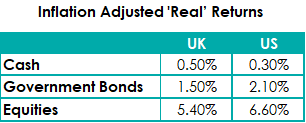Share this post
Real Returns
September, 2023
Our focus at Tacit has always been to generate ‘real’ returns for our investor clients over the medium to long term. Achieving this requires an understanding that generating positive real returns is empirically difficult, come s with risks over the shorter term and is not achieved in a linear straight line fashion.
The table below illustrates that over the past 97 years, the three primary asset classes (cash, government bonds and equities) have all generated positive real returns, however accounting for taxes and charges only equities provide enough return to offset the effects of inflation on your financial assets. This is true in the UK and also in the US.

Source: Barclays Equity Gilt Study, data from 1st January 1926 to 31st December 2022.
It may well be that cash interest rates at present provide a short term mirage to investors as they appear to offer high nominal returns over the next twelve months. In reality they do not provide positive real returns as inflation is still running at a higher level in the UK. It is likely that when inflation falls, as history shows, equity and bond market returns will exceed cash returns as well as provide a positive real return. When and how this happens is not forecastable, the fact that it will is. Remaining invested during periods such as this is fundamental to achieving your ultimate goal of achieving real returns.
Another interesting point about the longer term empirical data is that inflation in the UK has averaged 4.2% p.a., well above the Bank of England’s current target of 2%. A point that must be remembered and shows that the authorities have a poor record of controlling inflation at their 2% target.
Understanding one’s short term cashflow requirements whilst allowing an investment strategy time to generate positive real returns is a vital part of any family’s long term planning needs. Relying on short term evidence of the past 1, 3, 5 10 or 20 years does not stack the odds in your favour as an investor.
The past year is no more a predictor that the past 20 years. In reality, none of us really know what rate of inflation we will experience over the next decade. What we do know from the evidence is that an allocation to equities has the best probability of achieving the one thing all investors crave: preserving their purchasing power in real terms.
A longer term time horizon and allocating capital to equities is important for all investors as the data show. The question for each of us now, as always, is how much capital we need to hold back to meet our shorter term needs whilst being patient with our investments.
